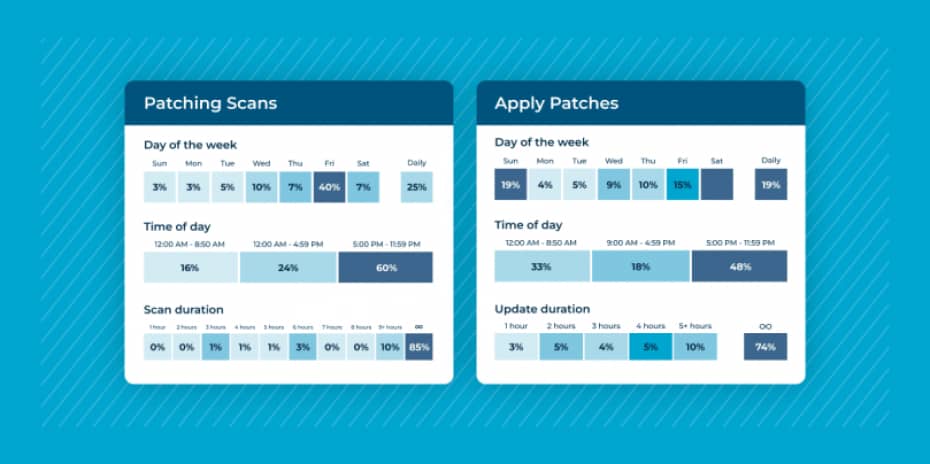Patching is an essential function within any MSP or IT department, so maintaining a successful patch management process is a top priority for organizations. A patch management audit is a specific type of IT audit that allows organizations to analyze and adjust their patching processes to make them more effective. Use this patch management audit checklist to evaluate and improve your current patch management process.
The purpose of a patch management audit
After completing a patch management audit, an organization will have all the information and data necessary to analyze and improve its patching processes. This data can reveal blockers and other issues that prevent efficient patching processes.
Generate insightful reports on patch compliance and vulnerabilities to make strategic decisions with NinjaOne.
5 benefits of auditing a patch management process
1) Identify & resolve blockers
Even organizations that follow all the best practices for patch management run into blockers. A thorough patch management audit helps organizations identify and resolve blockers in their patching processes.
2) Decrease security risks
“57% of data breaches are attributed to poor patch management,” Next Perimeter’s overview on the importance of patching clarifies. An audit will ensure that an organization’s patching provides the necessary IT security for a business.
3) Monitor compliance standards
Patch compliance refers to the number of devices that successfully receive patches, while patch management compliance refers to cybersecurity and patch management standards. During a patch management audit, an IT team can ensure that they follow all patch management standards.
4) Streamline processes
After identifying and resolving blockers, an audit also presents an opportunity to streamline current patching operations. For example, if the audit shows that your current patching is a slow process, consider automating it with patch management software.
5) Collect relevant data
Whenever a patch management issue appears, it’s helpful to have data from an audit to refer to and use. This is one reason why it’s important to keep records and documentation of previous patch management audits on hand.
A complete patch management audit checklist
When conducting a patch management audit, businesses follow a checklist or outline to keep the process on track. It also ensures that the audit is performed correctly.
A patch management audit checklist includes these steps:
- Perform an overview of the organization’s current patching policy and processes
- Determine patch statuses by scanning an organization’s network
- Look into unpatched vulnerabilities to identify the causes and trends
- Analyze risk-based decisions and procedures that influence patching processes
- Ensure that the correct metrics are used to accurately measure and record information
- Confirm that patch statuses are reported to the right team members or management
- Identify processes and areas for improvement
- Verify that patching expectations are written down and identified in contracts or agreements
6 best practices to follow when auditing a patch management policy
1) Set expectations
Set your patch management audit up for success with clear expectations and goals. To guarantee that the whole team is on the same page, write down all audit expectations and ensure that everyone involved in the process receives a copy. A patch management audit checklist helps with this.
2) Document relevant info
Throughout the patch management audit, document all relevant information. This data will help the team analyze current processes and find areas for improvement.
3) Conduct a thorough analysis
As you conduct a patch management audit, remember that this is a thorough analysis. Avoid just looking at the surface and dig deeper into patch management processes and systems to ensure that you gather all necessary data.
4) Never assume during an audit
When conducting a patch management audit, never make assumptions. It’s best to verify all information for yourself, even if the records show the systems haven’t changed.
5) Roll out changes incrementally
If you plan to make major changes after a patch management audit, roll them out incrementally and provide notice for all teams who will be impacted. Making major changes within your patch management system not only impacts your team but the entire organization.
6) Monitor all patch management changes
After implementing changes to a patch management system, monitor these changes closely. This will help determine whether the changes are actually beneficial for your patch management.
Make the most of your audit with our in-depth guide on ensuring effective and efficient patch management.
Update your devices with patch management software from NinjaOne
If your patch management audit reveals that you aren’t automating your systems, reach out to NinjaOne. With NinjaOne’s patch management software, you can automatically identify and resolve vulnerabilities from a single pane of glass. Start your free trial today and take the first step towards creating a more secure and streamlined IT environment.








